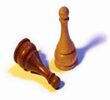All successful capture pursuits have to have a sound strategy, just like sports competitions or military campaigns. Win strategies help you run a pursuit in a way that separates you from the pack of your competitors. Essentially, you have to be able to articulate what will enable you to win. Your win strategy has to be written in a succinct set of statements, reviewed regularly to make sure it is still accurate and adjusted as necessary.
We are normally taught to define the strategy first, then the tactics. So, intuitively, many think that one has to start with defining the winning strategy first, and then you would develop action items (the tactics) to enact it. The actions that will enable you to implement this winning strategy, with clear priorities, deadlines, and targets assigned to each task.
After this is all set and done, right before the RFP hits the street, or while you are preparing a proposal, the approach is to develop the win themes that are reflective of the winning strategy, as a separate but related exercise. Win themes are recurring statements throughout the proposal that convey to the customer why your proposal should win, help your customer remember your proposal while they might read multiple others, and even lend them the language to justify to others why they want to award this proposal to you.
This traditional approach works sometimes, but it takes twice as long to implement. In many cases, the results are nothing to write home about—with win themes completely out of sync with winning strategies.
The secret of developing powerful win strategies that shine through your win themes and make your proposals more persuasive is counterintuitive: Start with developing win themes, not win strategies; win strategies will fall out of the action items that your win themes will drive.
The way you derive good strategies is to come up with win themes and perform a gap analysis in the process. If you cannot come up with a reason to select you for every evaluation criterion, every area of scope, and every customer desire, you need to honestly assess: Do you actually have the capability to provide the desired benefit your customer seeks? If yes, make sure you state the benefit, the feature, and prove it. If no, you have to come up with a strategy to obtain that capability, and figure out what actions will get you there. This is the inverted relationship between the win themes and win strategies. In other words, if you cannot come up with a complete win theme, you should create a winning strategy, and not the other way around.
Today, we have for you a bit of commentary on the latest procurement developments, a couple of announcements, and a short article revealing our secret of developing powerful win strategies.
Procurement developments:
If you have been monitoring SBA rule-making, you probably know that SBA is planning to add mentor-protégé programs for HUBZone, WOSB, and SDVOSB firms, in addition to the wonderful 8(a) mentor-protégé that benefits both small disadvantaged and large businesses. SBA predicts that the rules will come out in March 2013. In January, President Obama signed the National Defense Authorization Act for FY 2013 that includes a provision that would allow SBA to expand the mentor-protégé program to all small businesses, along with some language on the viability of mentor-protégé programs other than the SBA and DOD ones. There may be changes coming up soon—and we will keep you posted. As always, our courses and services will be up to date with the new information, as the Government contracting world changes.
Best regards,
OST Global Solutions, Inc.
…Because There is No Second Place in Proposals! TM
https://www.ostglobalsolutions.com
Contact us to learn more.

